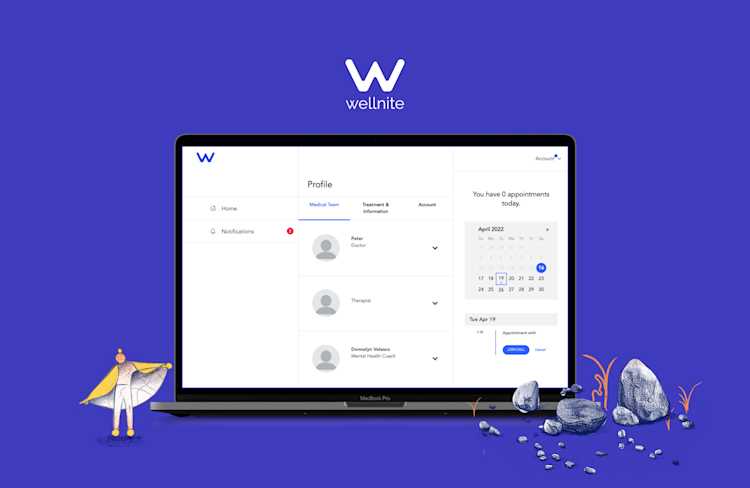How Wellnite is Powering a Mental Health Revolution with Whereby
Wellnite are on a mission to revolutionize telemedicine, destigmatize mental health, and help people access therapy from the comfort of their own homes.

Paulo González, Elisa Swan and Dr. Amy Halanski are on a mission to revolutionize telemedicine, destigmatize mental health, and help people access therapy from the comfort of their own homes. But their journey doesn’t start with telehealth therapy; it begins with diabetes.
It was 2018 and Paulo was running a company that helped people living with type 2 diabetes. When Paulo talked to patients, he learned their biggest challenges weren’t physiological. They were suffering from all sorts of mental health issues—depression, stress, anxiety, eating disorders, the list goes on.
Worse, they weren’t getting the support they needed. People had to wait three weeks to speak to a therapist or months to see a psychiatrist. And these were people with insurance. Paulo knew the problem must be many times worse for those without coverage.
Paulo and Elisa resolved to tackle the challenge by providing high-quality behavioral healthcare via HIPAA-compliant videoconferencing. Three years into their journey, they’ve made incredible progress.
Wellnite’s platform connects patients with dedicated doctors, therapists, and mental health. They deliver hundreds of telehealth sessions every day. Instead of waiting for weeks, people get the help they need in just a few clicks.
But getting to this point hasn’t been easy.
Building in a regulated industry
Back in 2019, Paulo and Elisa envisioned an online behavioral health service. They wanted people to be able to search online for providers and receive treatment via video chat. The problem was that healthcare is a highly regulated industry and secure, efficient, and compliant technology was rare.
The Health Insurance Portability and Accountability Act (HIPAA) regulates how companies manage protected health information. Unsecured video chat and unencrypted document storage were never going to work. Wellnite had to deliver a HIPAA-compliant service from day one.
Wellnite’s team designed an adaptable and flexible architecture. They had a core platform surrounded by different technology “regions” like video conferencing, note-taking, and calendar management. Instead of building their own technologies, Paulo searched for best-in-class HIPAA-compliant microservices.

Selecting Whereby to power Wellnite’s telehealth video conferencing was a simple choice. Paulo says implementation was a breeze. Instead of a lengthy technical integration, he could embed an iframe and go live straight away. Compared to other options, which were far more labor-intensive, Whereby allowed Paulo and his team to move fast.
Whereby’s team also helped him implement the technology to comply with HIPAA regulations. Using Whereby’s HIPAA-compliant add-on meant the technology was secure, but Paulo also designed HIPAA-compliant processes and policies (locked rooms by default, disabled streaming functionality, and so on) to keep patient data safe.
“Whereby’s tools have been a game changer for us. We can create HIPAA-compliant video rooms for every single session. It’s perfectly compliant with every rule and regulation.”
By integrating Whereby alongside several other microservices, Paulo’s team recreated a mental health professional’s workspace online. They could meet patients, deliver treatments, and prescribe medicines. Every last element was safe, secure, and HIPAA-compliant.
Wellnite gained traction—fast. They attracted dozens, then hundreds, then thousands of patients. Success snowballed and soon, the company was a sustainable business.
While their first platform was compliant, it wasn’t particularly user-friendly. Paulo describes it as a “Frankenstein” system. Therapists would use one link to open their video conference and another link to access patient records. But that was soon to change.
Trust, partnerships, and growth
By relying on HIPAA-compliant microservices like Whereby to power its platform, Paulo could focus on delivering value for his patients and partners. Those relationships helped Wellnite evolve into the platform it is today.
Wellnite’s team is in constant contact with providers. They’re asking what’s working and what needs improvement. Update by update, Wellnite began to evolve into a cohesive system.
“Partners see the progress from six months ago. They see the hard work we’re putting in. They see that we’re listening, iterating, and improving.”
Today, the platform is a joy to use. Behavioral health specialists log into one platform—Wellnite. While there are four or five microservices running at any one time, partners don’t need to see that.
Whereby integrates into Wellnite with a few lines of code. It’s not a bulky add on, rather a cohesive piece of the platform. That’s true for other microservices, too. Using their APIs, Paulo pulled everything into one system and built the user interface on top.
Therapists see a video call in the center of the screen, patient records on the left, and note-taking on the right. It’s cohesive and simple. It allows them to focus on what’s most important: delivering world-class healthcare.
Paulo says it’s satisfying to pay back the trust of his partners, patients, and vendors. Some have been with Wellnite from the start. They joined because they saw what his company could become, not just what it was.
“At the start, I had to convince people to trust me,” he says. “But then we got a spark and a little break and traction. Then we delivered what they believed we could. It’s so rewarding.”

Fixing a worldwide problem
Healthcare is a complex market. Wellnite has to deal with many different stakeholders—healthcare providers like therapists, private insurance networks, and, of course, patients. It’s a lot of work, but Paulo and his team nurtured those relationships.
Today, Wellnite is in-network with all major insurance providers and they deliver services in 47 U.S. states.
“I think we're gonna see amazing stuff happening in the mental healthcare space, especially in the telehealth space.”
Paulo’s next goal is public insurance. When he started Wellnite, he committed to supporting patients regardless of their zip code or insurance coverage. Through Medicare, Medicaid, and public health companies, he can bring behavioral health support to those who need it most.
As Wellnite grows, its tech stack will grow with it.
Paulo carefully selected microservices like Whereby that can scale with fast-moving organizations. Whether it’s supporting 100 patients a day or 100,000, Whereby doesn’t break a sweat. That’s good news because Wellnite’s American ambitions are just the start.
Poor behavioral health support is a worldwide challenge. Paulo plans to take Wellnite overseas to English-speaking countries like the UK, Australia, and New Zealand. Then Latin America and Europe. As Paulo puts it: “The goal is to be everywhere.”
Companies like Whereby and Wellnite are powering a telemedicine revolution. They’re broadening access, removing barriers, and destigmatizing the industry. Paulo is excited about the future.
“People are embracing mental healthcare,” he says. “They’re becoming more aware of the technology and resources available to them. As technology evolves, online mental healthcare will go into a different league.”


